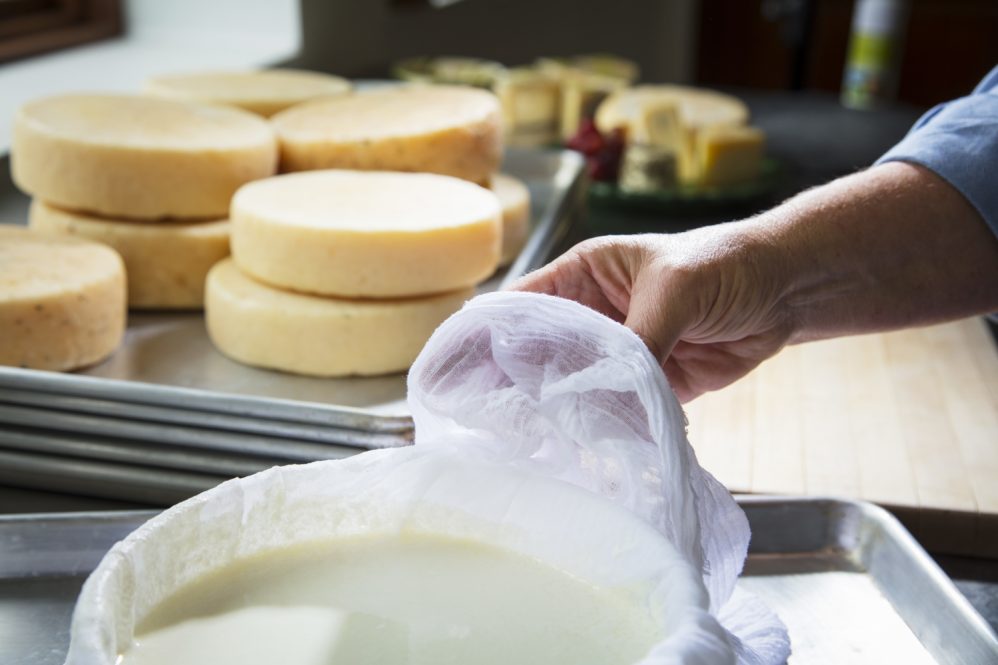When unpasteurized milk is used to make cheese, the result is a product with more complex flavors, meaning many consumers seek out cheese made from “raw” milk. However, if the milk was contaminated, the cheese it’s used for can harbor pathogens that make people sick. This is where “protective cultures” can help.
UConn professor and Extension educator Dennis D’Amico recently published research he hopes will help cheese producers choose which cultures may help keep cheese made from unpasteurized milk safe. The research detailing the process and findings are published in Food Control.
D’Amico says the project came about to fill a need identified through his integrated research and extension program.
“I work with artisanal cheese makers and they would ask if the protective cultures available worked. I wasn’t sure and I wanted to be able to give them answers,” he said.
In the cheese-making process, milk is combined with starter culture and ripening microorganisms, chosen specifically for the type of cheese being made. Under the right conditions, the microorganisms will grow and utilize nutrients within the milk. After a period of aging, the cheese is ready to be eaten, hopefully free of pathogenic bacteria.
“With cheese production, you are relying heavily on good bacteria,” says D’Amico.
D’Amico explains that methods used to preserve other types of foods cannot be applied to cheese for various reasons; for instance, adding enough salt to inhibit microbe growth will result in salty, inedible cheese, while altering the pH level of the product could result in the wrong type of cheese.
“We can do physical things like heat the milk, but that kills some of the good bacteria and will change the product,” says D’Amico.
Beyond these constraints, there are also rules and standards that list the ingredients can be added to the process and result in something that can still accurately be called “cheese.”
“For instance, there is a good definition around what cheddar can be made with,” D’Amico says. “These rules are for consumer protection. If you add things that are not on the list, then it can’t be labeled as cheddar.”
The regulations have been in place since the 1940s and have not changed since, so finding innovative ways to avoid contamination can be tricky, says D’Amico, especially since outcomes are not always predictable when working with biological systems.
“What we can do is add bacterial cultures, because that is an allowable ingredient,” he says. “For this project, the idea was to investigate cultures that are already commercially available.”
The idea of using protective cultures is not new, but it appears to be one of growing interest, says D’Amico. The project started about five years ago, and over the years the researchers have re-run the experiment to test new cultures that have come onto the market.
“The idea of protective cultures is built on the fact that bacteria compete with each other in the environment, and to do so they have adapted ways of producing a variety of antimicrobials to give them a competitive advantage in the natural environment,” says D’Amico.
By using the right cultures or the right combination of cultures, the protective cultures will ideally be able to out-compete pathogenic microorganisms to keep them from spoiling the food, or harming anyone who consumes it.
“My idea was to come up with a matrix to provide to the cheesemakers that would show which cultures were compatible, and whether the cultures would change the qualities of the cheese they are producing,” says D’Amico.
To do this, researchers tested nine commercially available protective cultures against various pathogenic bacterial cultures, individually or in combination. They first tested in growth media in the laboratory to determine the antimicrobial activity of the protective cultures, and then the cultures were tested in milk.
What the team found was that the protective cultures inhibited pathogen growth for the most part. D’Amico says one of the exciting aspects about this project is that most protective cultures on the market deal with “gram positive” bacterial pathogens like Listeria; however they found new protective cultures that deal with “gram negative” bacterial pathogens, including E. coli and Salmonella, which are problematic not only for cheese, but also for other foods such as produce.
“E. coli and Salmonella can be in raw milk, but in the case of Listeria, it is an environmental contaminant, it can be on equipment for instance,” says D’Amico. “One of the exciting takeaways from this work is we have protective cultures that can be effective against all of these types of bacteria.”
Encouraged by the results, D’Amico says it is good to know which cultures work under certain conditions, as well as having insight into compatibility, which constitute vital information for cheese makers.
“Now we have an educated response for producers when they ask ‘Do these work?,'” he says. “We know they are worth a try. We hope this information will be helpful to cheese makers.”
This work was funded by the National Research Initiative of the USDA NIFA 2017-67018-26170 and the George H. Walker Milk Research Fun AG180521 and AG170588.



